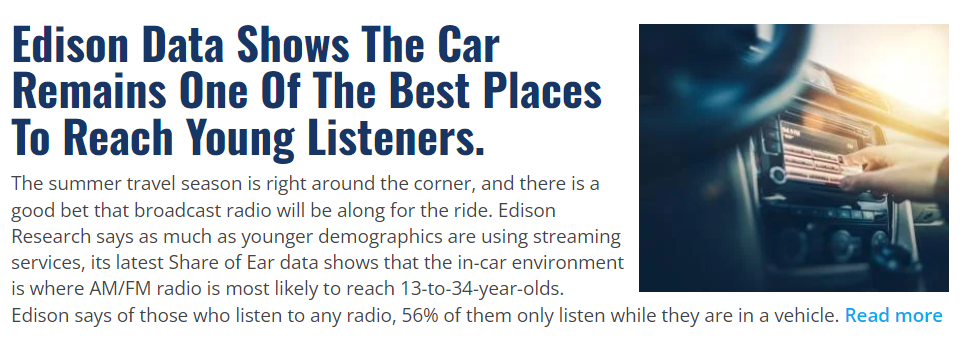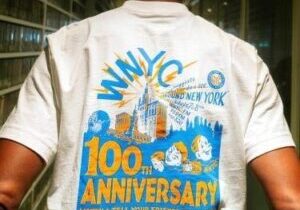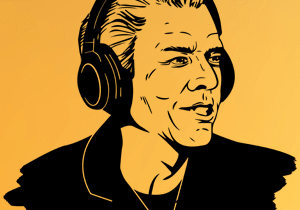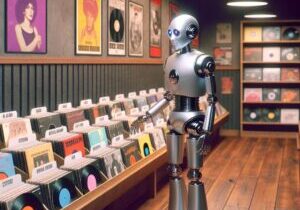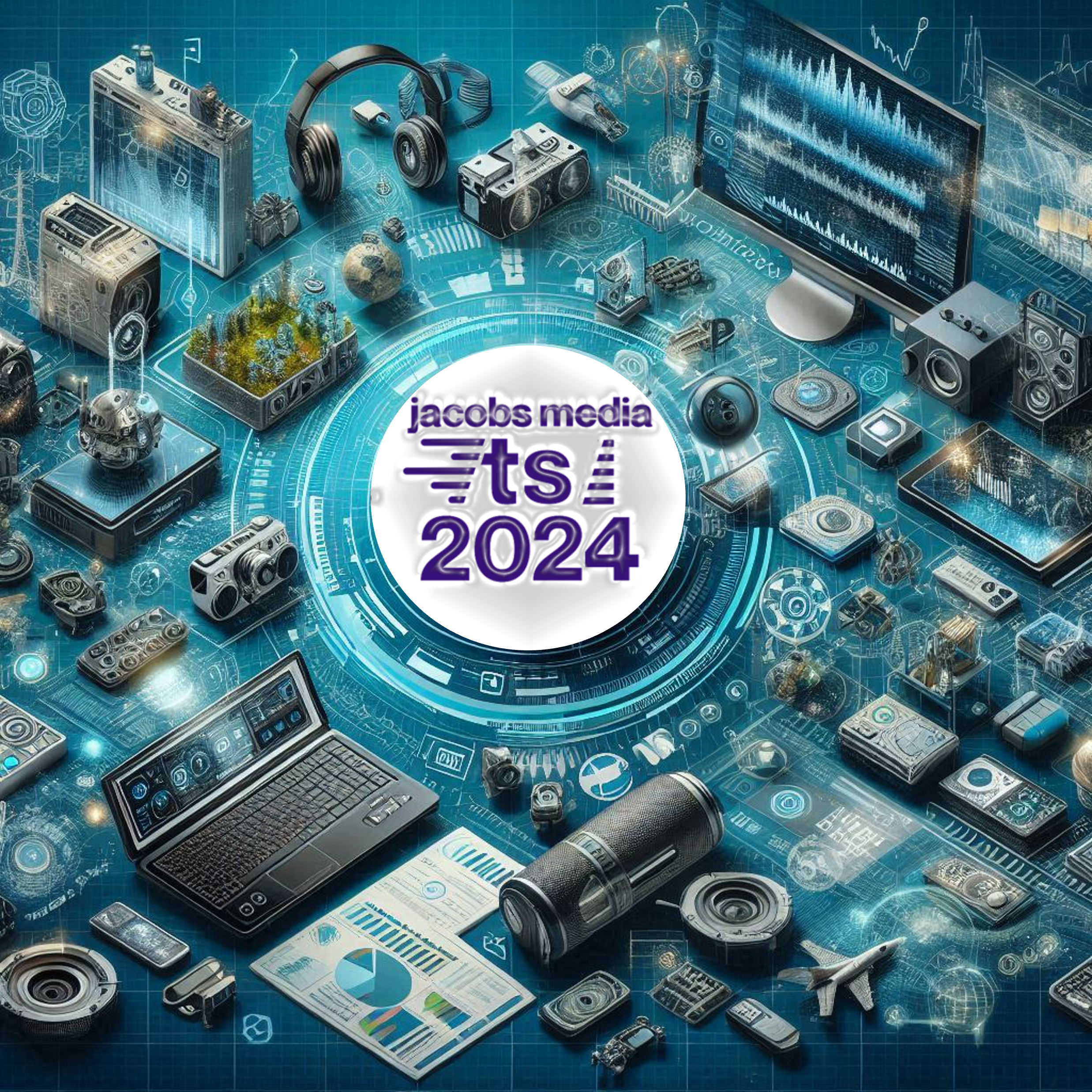
These are always exciting weeks for me. On Thursday, I get to present the top-line results of Techsurvey 2024 to hundreds of interested radio professionals. And even though this particular survey is comprised of commercial radio users from the U.S. and Canada, I noticed while perusing the list of registrants to our webinar on Thursday we have many representatives from public and Christian radio. This tells me there is a great deal of interest in insights and answers about radio, media, and how they are transforming our lives.
And why not? We talk often about how we’re at an inflection point with media in general, and broadcast radio specifically. I’ve been at this for a while, and I’m hard-pressed to think of another time this turbulent or disruptive – and that covers numerous financial meltdowns, COVID, and 9/11. No doubt, the pandemic was an off-the-charts event that shut down our cities – and our lives – but the changes roiling the world of media today strike me as equal parts unique and concerning, especially heading into an election in this country that also appears to be that existential fork in the road. We need research, now more than ever, that can help us navigate these increasingly rough waters.
Techsurvey 2024 is a special one for the me and the Jacobs Media team because it’s our 20th survey in this series. Two decades ago when this survey debuted, the iPhone hadn’t yet come to market, Facebook was expanding beyond college campuses, and YouTube was being launched. In 2004, there were no smart speakers, Air Pods, smartwatches, or AI. And yet, all these technologies are now integral parts that explain the how’s and why’s behind how millions consume media content. As I often remind those who attend my presentations and speeches, “Content IS king,” – of that, there is no doubt – but in our techie times, “Distribution IS queen.”
That is, we must continue to set a high bar on the content radio organizations produce. Given the expanded field of brands and platforms, radio either needs to play at a high quality level or face the reality of getting out of the game.
But the other side of the equation is that as good as our content may be, if it’s being distributed on channels and devices unavailable to many consumers, they can’t enjoy it if they cannot receive it. In other words, great morning shows can’t be heard over the air if a listener doesn’t own or have access to a radio. Understanding how to reach audiences where they are is the schematic stations need in order to plot out a coherent content and distribution strategy.
Enter Techsurvey. Our “pyramids” provide a comprehensive look at how various audiences use media, gadgets, and platforms. One of my favorite pyramids from Techsurvey is pictured below – the “Generational Pyramid” juxtaposing Millennials with Baby Boomers to understand how each key demographic interfaces with their desired. On the left, I used the symbol of the Millennials generation – Taylor Swift – to note distribution points these listeners use more than their Baby Boomer parents and grandparents. And as you can see, there are lots of little “Swifties” dotting the entire left side of the Millennial pyramid. From podcasts to smart speakers to audio streaming to social media, Millennials outdo Boomers in most dimensions.
But Baby Boomers have a few moments where they stand out. On their side of this dual pyramid, I used a Boomer musical icon – James Taylor – to mark media, gadgets, and actions more common to those north of age 60. A look at their habits reveals more Boomer usage of AM/FM and HD Radio, TV/video, and satellite radio.
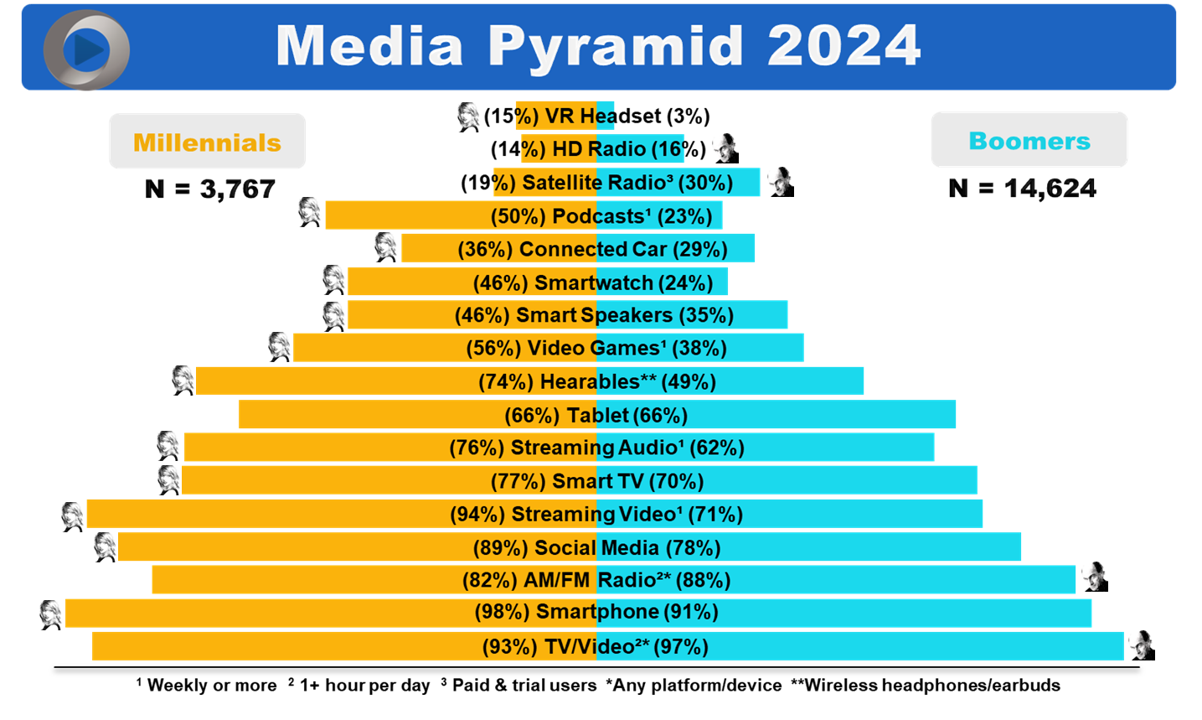
Of course, we produce pyramids for all 10 formats included in this year’s Techsurvey. That provides in-depth media usage data for fans of country, CHR, rock, AC, Sports, Classic Hits, News/Talk, and several others. We also track the audience generationally, by gender, and other “data cuts” that allow our stakeholders to more clearly see the playing field.
The other angle that makes Techsurvey data come alive is when we see a key headline in the news, and we can gain perspective on what it might mean through the radio lens. And we get smarter when we glean insights from tracking. Some questions – like Net Promoter – we’ve been asking for 20 years now. It provides huge learning opportunities to see how this data trends over time, and how brands and platforms are impacted.
I’ve pulled three recent stories about media and technology that jumped out at me, and pulled corresponding charts from Techsurvey 2024 so you can see how we approach the analytical part of the study versus the reality of media usage. Here’s how it works:
This story from earlier this month revolves around whether the movie theater industry can make a comeback, especially in the wake of COVID. At the CinemaCon conference, the movie theater industry expressed hopefulness their business can bounce back. Many express the belief that more major movie releases post those two debilitating Hollywood strikes can be difference makers.
The research suggests they are faced with a long, uphill struggle. In a new question in Techsurvey 2024, we looked at entertainment preferences post-pandemic. And one area investigated the choices we make when it comes to dining, concerts, and yes, movie theater attendance.
For meals and music, it’s about going out and experiencing. While we can enjoy a meal delivered to our door pretty much any time or a concert on our big screen TVs (with no long bathroom lines or those annoying people dancing in front of us for the entire show), going out to the movies is a whole different thing.
Given the choice – seeing a new film at the theater or streaming it at home – respondents are clear in their preference to enjoy a movie in their home theaters, “man caves,” or on a screen they’re holding in their hands.
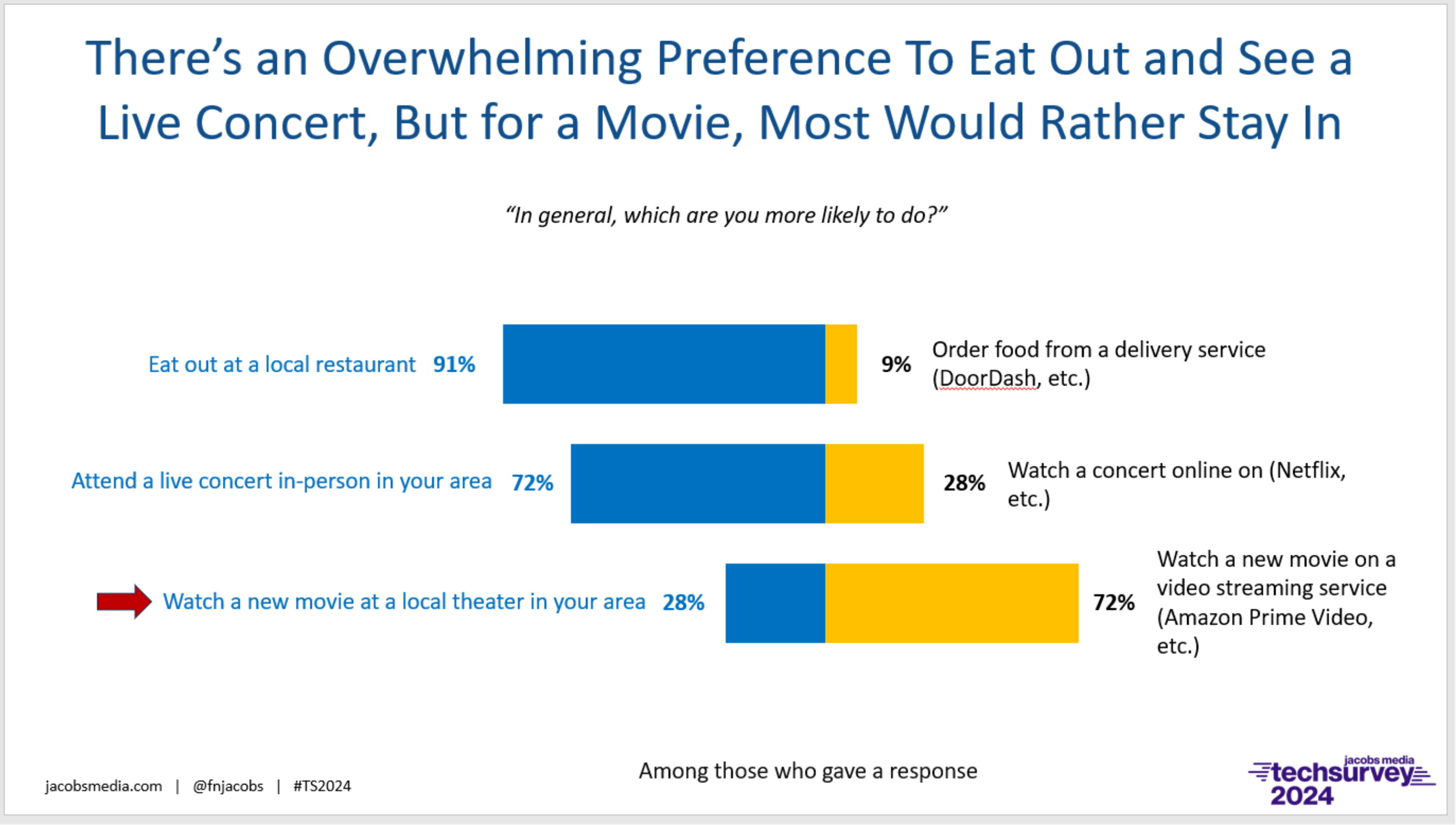
To a radio station promotions department, the implications are obvious. Giveaways that involve free meals or concerts will likely resonate, assume you’re working with popular restaurants for your audience and performers most listeners enjoy.
Scoring the movie premier, however, would appear to have serious limitations – at least for now. More than seven in ten respondents opt for the in-home experience for new films, much to the obvious disappointment for anyone who works in the theater industry. It suggests that in order to attract consumers to theaters on levels we remember pre-2020, the theater masterminds will have to be innovative and create experiences that make theater-going worth leaving the house for. Right now, it’s not.
The headline above made most of our industry trade publications, including Inside Radio. It summarizes a key research finding about reaching teens and twentysomethings via the radio.
Skeptics will tell you “they don’t even know what a radio is.” But the truth is, a whole lot of Z’s do what we all do – reach for the technology that’s right in front of us. In this case, it’s radio in the car. As the Infinite Dial data reminds us, however, the car is about the only location where most of them experience broadcast radio.
Even though Techsurvey 2024 only includes 382 Gen Z respondents, we see the same pattern. When we look at those who say that “all” or “most” of their listening time to AM/FM radio is while they’re on four wheels, Gen Z (and Millennials) fall into this grouping.
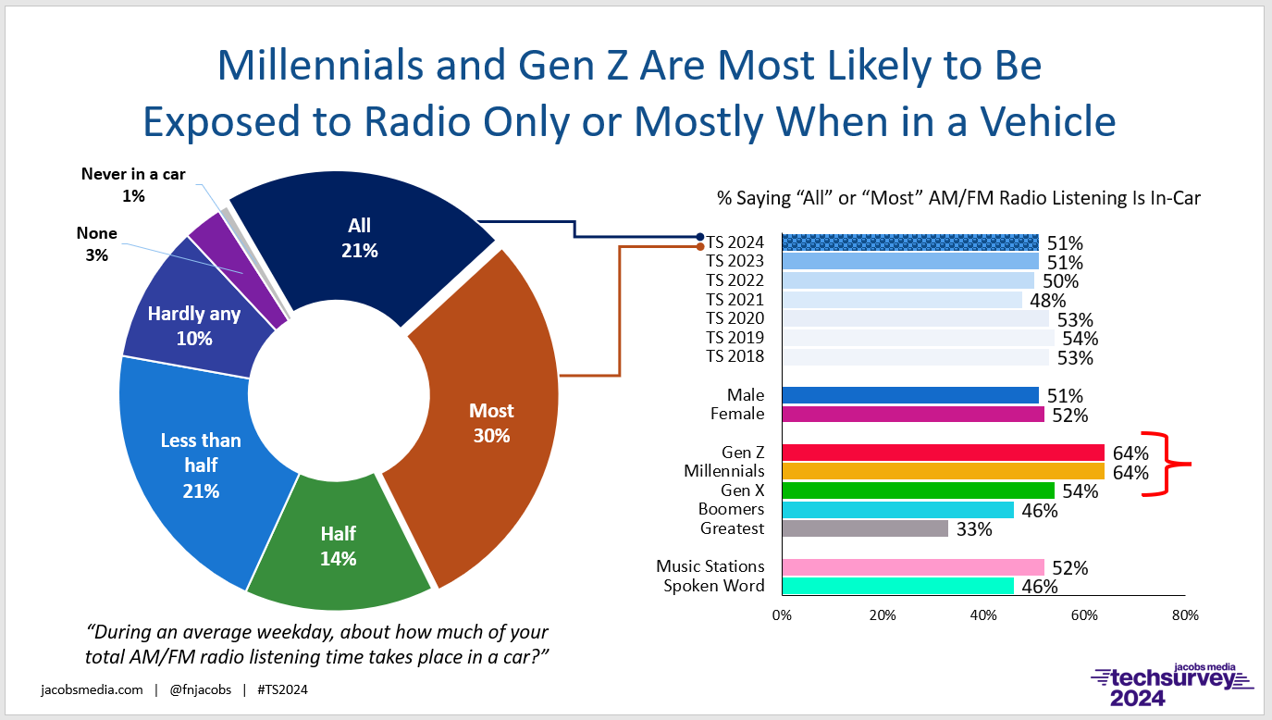
So, what might actually happen if a radio station decided to buck convention and actually put a teen-targeted station on the air? Would there even be an available audience for this type of format?
The data – Edison’s and ours – suggest it might very likely be sampled while they drive or are in a car. And extrapolating a bit, given Gen Z’s addiction to their mobile phones, an attractive format could eventually attract listening in locations outside the car. But the clock is likely ticking on the viability of a legitimate Gen Z product succeeding in attracting OTA listening.
The final headline is from tech guru and good friend, Shawn DuBravac. It traces the history of the Apple CarPlay ecosystem, as well as the company’s failed venture to create its own branded car. Writer Mark Gurman in a feature called “Power On” explores Apple’s wild ride in the automotive space.
Google (Android Automotive) has made headway with its system in recent years, leaving Apple at an uncomfortable position in its effort to conquer the automotive space. Gurman previews a new CarPlay interface (below) but explains Apple may be running out of real estate in the dashboard.
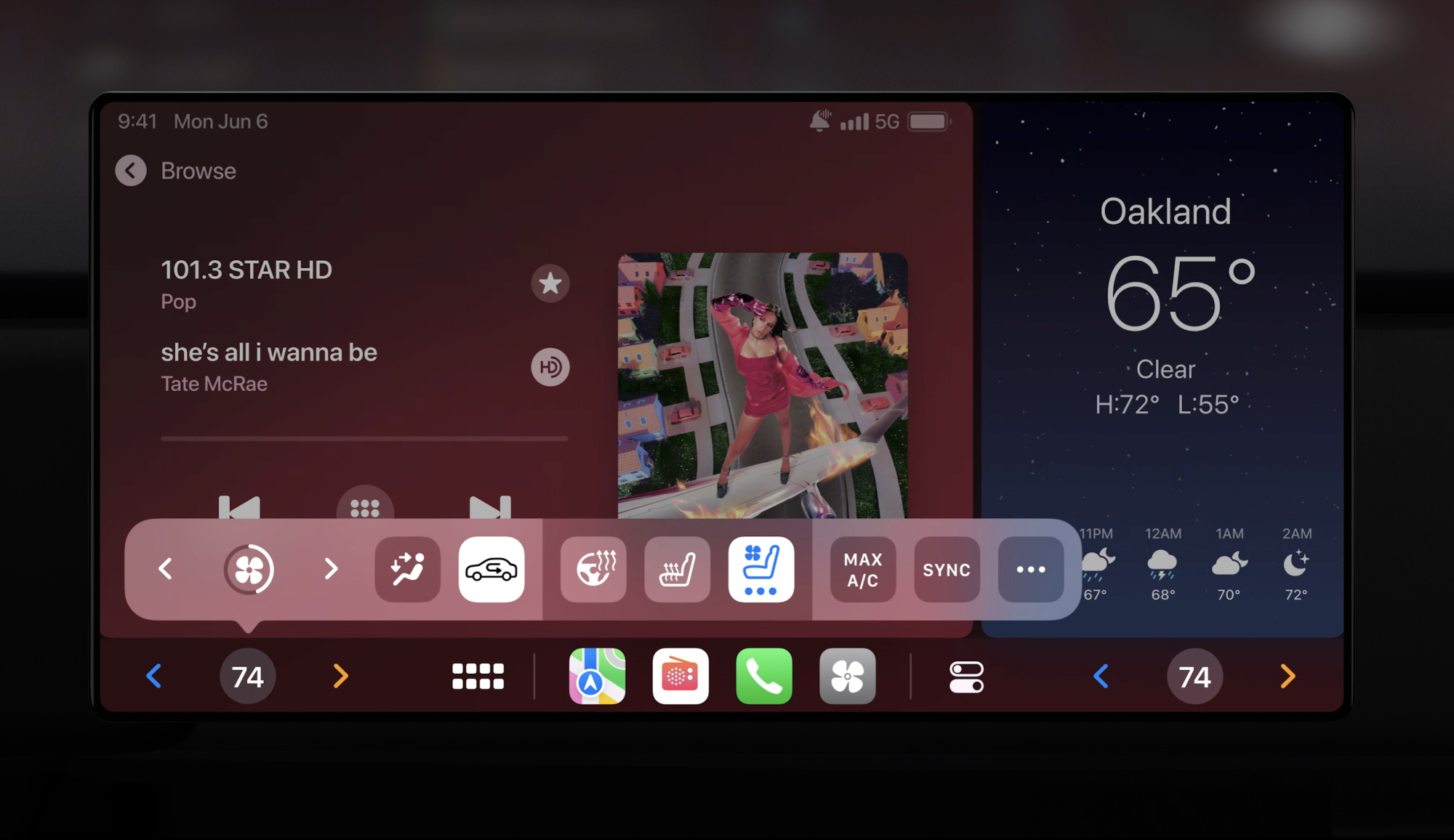
As Gurman points out, one of Apple’s remaining weapons is the popularity of CarPlay among vehicle owners: “Both Apple and the carmakers know there are diehards who won’t consider buying a vehicle if it doesn’t offer the feature.”
For Apple, that’s a risky strategy, but perhaps a viable one. A niece of mine visited us in Florida a couple years ago. They told me they planned to rent a Mustang convertible, which they were excited about. But when they pulled up, they were driving a Chevy Camaro. When I asked about the discrepancy, they explained to me the Mustang’s Apple CarPlay was malfunctioning, so they opted instead for the Camaro where the system was working just fine. That’s right – the dashboard trumped the make and model of the vehicle.
Stories like that suggest CarPlay has made progress in winning over legions of iPhone owners looking for a similar experience when they’re in their cars. The slide below from Techsurvey 2024 illustrates the dramatic growth curve for CarPlay:
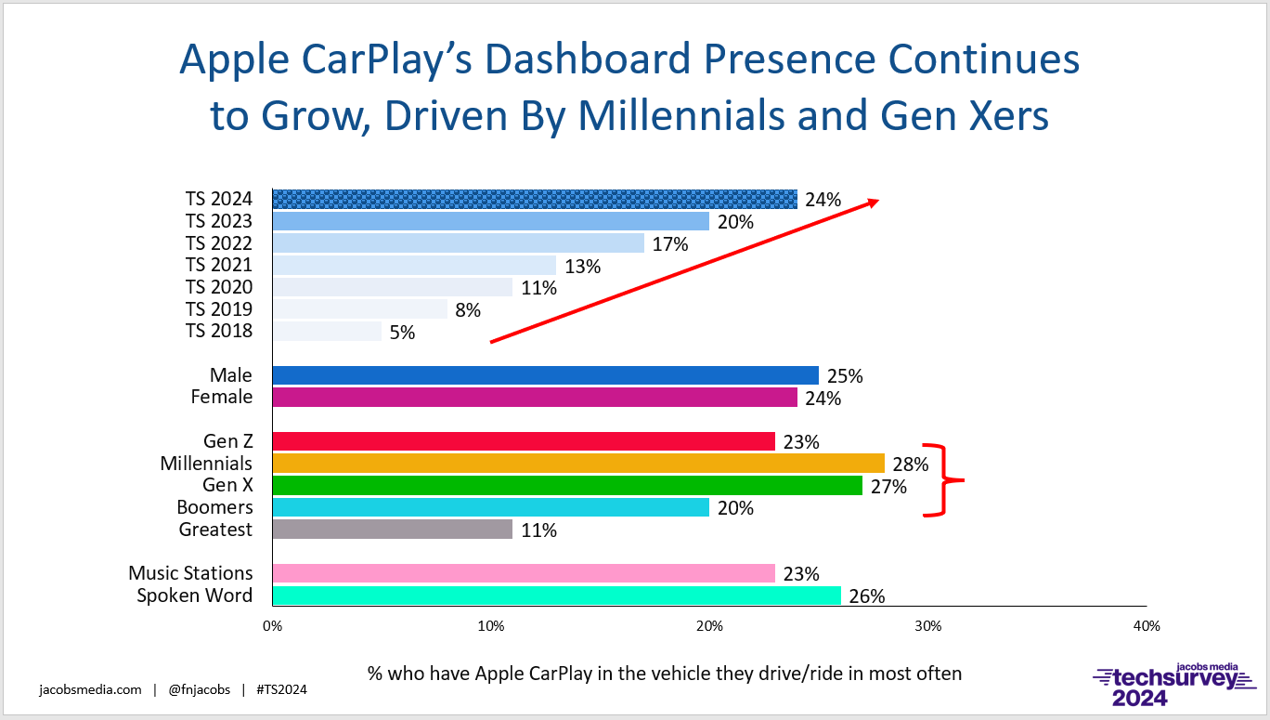
Right now, nearly one in four core radio listeners in Techsurvey 2024 is driving around in a CarPlay-equipped vehicle – up nearly 5x from 2018. As expected, the youngest generations are especially likely to have Apple’s infotainment interface in their dashboards.
Oddly enough, General Motors is eliminating CarPlay in all their vehicles. Our data indicates this decision could end up being a disaster, impacting young car buyers in particular. As many are in the process of purchasing or leasing their first car or truck, GM is telling them they cannot have a feature many clearly enjoy and value.
For radio stations, this data has other implications. Mobile apps that aren’t CarPlay compatible are problematic. When this system is activated (often from the moment one gets in the vehicle), the AM/FM tuner is hidden, revealing only apps on one’s iPhone. If one of those apps isn’t your station’s, you’ve put yourself and your business at risk.
These are just a few of the insights I’ll be sharing with you Thursday afternoon. Our AI data, in particular, is eye-opening and has implications for every radio company trying to plot out a strategy for this technology. I’m eager to show you what 31,800+ had to say about radio and the larger tech ecosystem.
The worlds of media and technology are careening through our lives. Now more than ever, we need reliable, actionable data that provides guidance and confidence.
Back in the ’70s, we hitchhikers in the galaxy could simply respond with “42” – author Douglas Adams’ convenient answer to most mysteries and dilemmas. 
We’re going to need a lot more numbers to figure this all out today.
Note: Every article in this post is linkable back to its source. Just click on the headline.
Hang out with me for an hour this Thursday, April 25 at 2pm ET for the industry presentation of Techsurvey 2024 in collaboration with Inside Radio and sponsored by Quu. Bring the staff and let’s talk about what the data means to radio. Register here.
Originally published by Jacobs Media

